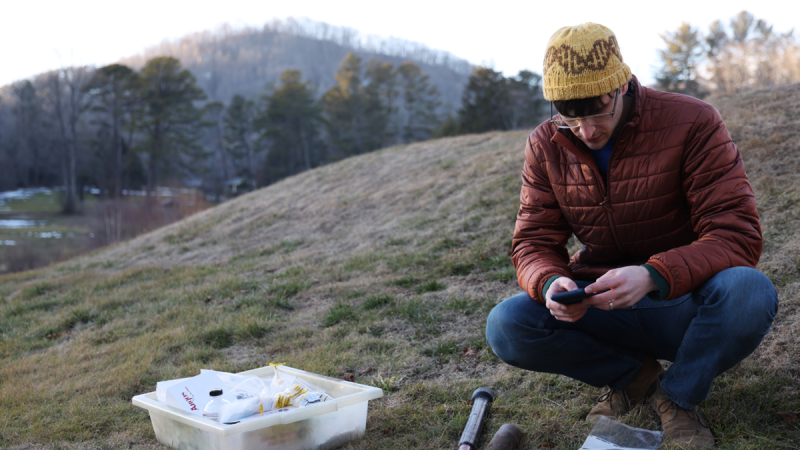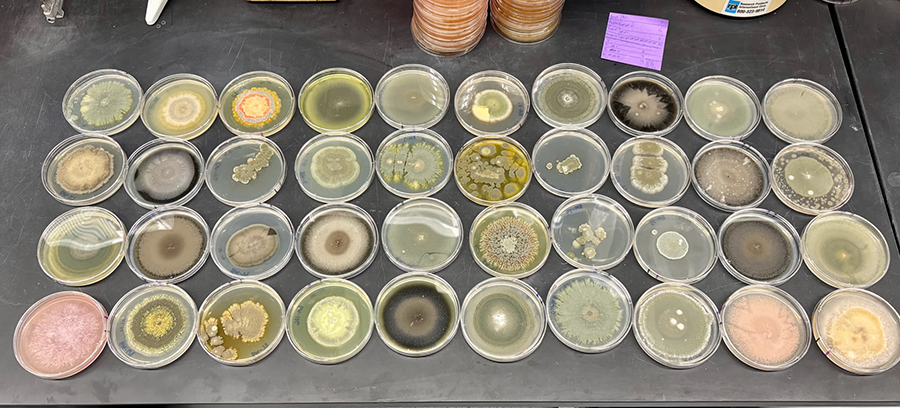
The Fungal Fallout of Climate Disasters
First came the rain. The predecessor rain event flooded historic Biltmore Village, submerging roads and businesses before Hurricane Helene even made landfall. Residents in Western North Carolina braced for power outages and small mudslides, but no one anticipated the devastation that followed.

When Helene hit, the Swannanoa River rose an unprecedented 27 feet in Black Mountain, inundating neighborhoods, washing away infrastructure, and leaving residents without power for weeks and clean water for months. As floodwaters receded and communities came together to clean up and rebuild, mold and other fungi began to thrive in the damp, waterlogged spaces.
Now, a newly formed team of Duke University researchers called Climate and Fungi (CLIF) is working to understand how these fungal communities develop and what they mean for human health in a warming world.
Work by CLIF began in the Department of Molecular Genetics and Microbiology at Duke University School of Medicine. Early investigators included Erica J. Washington, PhD, assistant research professor in molecular genetics and microbiology. She was inspired to pursue the research after listening to geneticist and mycologist Joan Bennett, PhD, talk at the International Symposium on Fungal Stress in September 2024 about ways fungal growth after natural disasters can make people sick.
As Washington returned home from the symposium, Hurricane Helene was battering the state.
“It can’t be by chance that we heard this amazing talk about how hurricanes and climate change and fungi are affecting people’s health while an unprecedented event is happening in Western North Carolina,” she said.
Within weeks, Washington, and Asiya Gusa, PhD, a molecular genetics and microbiology researcher at Duke Medical School, met engineering expert Andrew Jones, PhD, at a climate forum on campus. Their conversation sparked an idea to investigate how fungi thrive in post-disaster environments and the risks they pose.
Soon after, Julian Liber, a graduate student studying biology, and Vesper Fraunfelter, an Asheville, NC, native and research technician in molecular genetics and microbiology, joined, completing the interdisciplinary team ready to study a changing world.
The Hidden Aftermath
Each CLIF investigator brings something different to the table, from human and environmental health impacts to building design and mitigation.
Washington focuses on a fundamental question: As global temperatures rise, will fungi become more heat-tolerant -- and more dangerous?
Typically, human body heat protects against fungal infections. But climate change could shift that balance. If fungi, which thrive in cooler environments, adapt to higher temperatures, the risks could increase. Fungal infections account for 6.5 million illnesses and 2.5 million deaths worldwide each year and can be difficult to treat.
Jones examines how to improve flood recovery through safer and more effective cleanup methods; Fraunfelter investigates the release of mycotoxins, toxic compounds produced by certain types of fungi and molds; and Liber explores the spread of microbes, including fungi, into homes during natural disasters.
Their research could lead to real-world improvements in disaster recovery.

In January, the CLIF team visited Black Mountain, one of the areas hit hardest by hurricane flooding. They collected fungi samples from two maintenance facilities—one slated for demolition, the other already remediated—as well as from the newly remodeled baseball fields at Veteran’s Park.
Every sample collected by the Duke team contained thriving fungal communities. Even after a site had been cleaned up, or “remediated,” fungal spores remained present and continued to grow. It suggests that cleanup methods might not fully eliminate fungi and gaps may exist in existing remediation protocols.
“If your building survives a flood,” said Jones, an assistant professor of civil and environmental engineering at Duke Pratt School of Engineering. “The next challenge is making sure it survives the mold growth that follows.”
After collecting the samples, Fraunfelter began isolating the different species growing on the collection plates. “A random patch of wall is going to have a dozen different things growing on it,” Fraunfelter said. “We want to isolate them and probe individual species of interest.”
The Microbiome Core Facility is analyzing the samples and once the results are in, the CLIF team will be able to dive into research.
Engineering Resilience
Jones’ research blends engineering with policy analysis to take on big global challenges around water and public health. Having grown up in a home affected by flooding, he is particularly focused on improving recovery strategies and understanding how mold impacts the places where people live.
“I want to be able to learn from our experiences with flooding so that people don’t have to go through flood cleanup the same way that I did and the way that residents of Black Mountain are having to now,” he said.
Bleach is commonly used for mold cleanup but can lead to harmful fumes that can cause coughing and irritate eyes, nose, and skin. It doesn’t penetrate porous materials like wood or drywall, where mold typically grows and establishes roots. Bleach only kills surface mold, leaving the roots intact, which can lead to mold regrowth. However, it’s not easy to find bleach alternatives.
The engineering expert hopes CLIF’s research will lead to safer cleanup methods, better building materials, improved plumbing and HVAC systems, and public health policies to tackle fungal threats before disasters happen.
“We need outside airflow that doesn’t necessarily move through our HVAC system,” Jones said. “We are finding that fungi growth is occurring within the HVAC system, which then spreads throughout the rest of the house.”
Microbes on the Move
Scientists are still unsure how fungi might adapt to rising temperatures, but they already know many fungi can be harmful to humans.
Mold, for example, can release potentially toxic chemicals and gases into the air, known as mycotoxins which can cause health problems like allergic reactions, asthma attacks, and respiratory issues, according to the U.S. Centers for Disease Control and Prevention.
By studying samples collected from Black Mountain, researchers hope to better understand the health risks mold and other fungi pose after flooding. Their findings could also pave the way for new drug targets and easier ways to treat fungal infections.
The project also offers a chance to study how fungal and bacterial microbes spread in the wake of natural disasters. Liber has found nearly identical yeast strains in locations as distant as Alaska and New Hampshire. Could hurricanes and extreme weather events be transporting microbes from one region to another?

By comparing samples inside flooded buildings to those in surrounding soil and vegetation, Liber hopes to map microbial movement and identify which organisms pose the greatest risks.
The CLIF team is still in its early stages. But its work has the potential to reshape how communities prepare for and recover from climate-driven disasters. Researchers are working to secure more funding to expand their research and plan to visit Asheville for additional sampling in the coming months.
As climate change fuels stronger storms and more frequent flooding, the team’s findings could help protect both homes and human health.
“This isn’t just about mold in buildings,” said Washington. “It’s about understanding how a warming world is changing the very microbes we live with – and what that means for all of us.”
Alissa Kocer is a communications strategist in the Office of Strategic Communications at the Duke University School of Medicine and lives in Asheville.
Photos and video by Daniel Dunston, senior multimedia producer in the Office of Strategic Communications.
